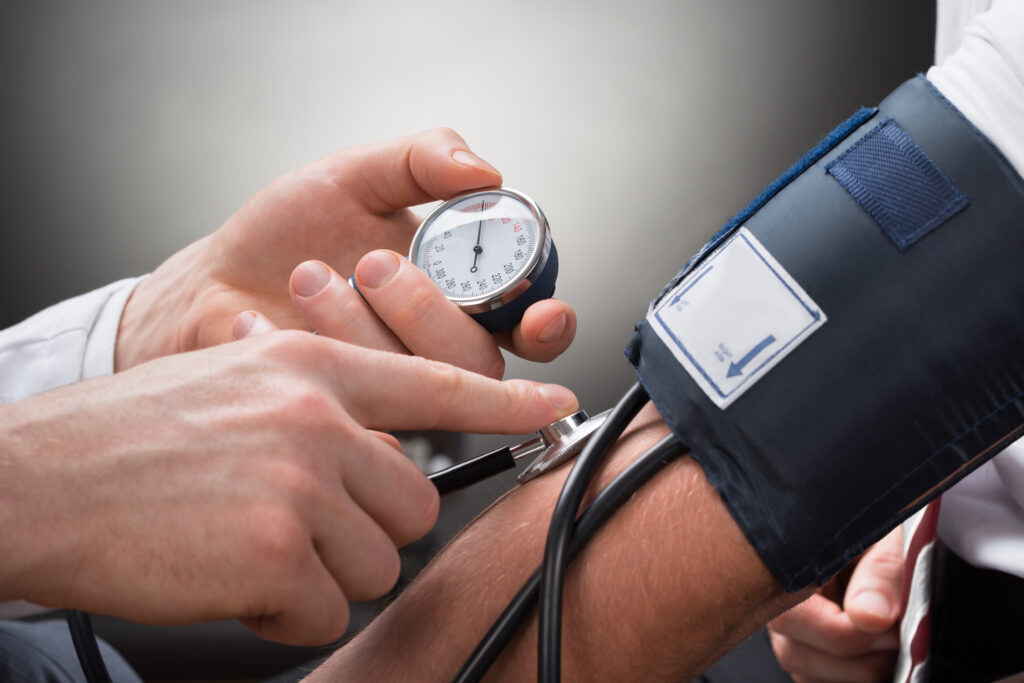
This graph of the least-squares average of blood pressure readings over an almost two-month period shows a reduction from 141 to 123 in systolic blood pressure of one student in the University of the Heart, Class of 2012, who practiced Heart Rhythm Meditation daily.
Slowing the breathing rate has been shown to reduce blood pressure. Within a few minutes, the muscles surrounding the small blood vessels dilate [relax], allowing blood to flow more freely, resulting in lower blood pressure.

The research cited below shows that with a breath rate of 10 breaths per minute, blood pressure is reduced up to 36 points systolic and 20 points diastolic. Average reductions in seven clinical tests were 14/9 points.
Heart Rhythm Meditation lowers the breathing rate even farther to 5 breaths per minute. Advanced practitioners reach 3 breaths per minute. We have found that the average person can easily learn to reduce their breath rate to 5 breaths per minute, without the use of any monitors or instruments, through Heart Rhythm Meditation. Five breaths per minute is accomplished with a six-second inhale and a six-second exhale.
“Normal” Blood Pressure May Still Be Too High
A new study of heart disease patients finds that “normal” blood pressure may not be low enough. By reducing their pressure well below the levels suggested by national guidelines, patients had fewer heart attacks, strokes, cardiac arrests, hospitalizations for chest pain, and procedures to open blocked coronary arteries. The study showed that the risk of heart attacks increased continuously as systolic blood pressure climbed above 115. (Reported in the NY Times, Nov. 10, 2004)
Research Studies in Peer-Reviewed Publications
These studies are cited by the makers of “Resperate”, an electronic device that guides one into rhythmic breathing. Heart Rhythm Meditation also creates rhythmic breathing, at an even slower rate, without an instrument, by feeling the pulse or heartbeat.Respiration and Blood PressureParati G, Izzo JL Jr, Gavish B., in Hypertension Primer, Third Edition. JL Izzo and HR Black, Eds. Baltimore, Lippincott, Williams, and Wilkins, 2003; Ch. A40, p117-120.Treating hypertension with a device that slows and regularizes breathing: a randomised, double-blind controlled study.Schein M., Gavish B., Herz M., Rosner-Kahana D., Naveh P., Knishkowy B., Zlotnikov E., Ben-Zvi N., Melmed R.N., Journal of Human Hypertension 2001; 15:271-278.Breathing-control lowers blood pressure.Grossman E., Grossman A., Schein M.H., Zimlichman R., Gavish B. Journal of Human Hypertension 2001; 15:263-269.Device-Guided Breathing Exercises Reduce Blood Pressure – Ambulatory and Home MeasurementsRosenthal T., Alter A., Peleg E., Gavish B., American Journal of Hypertension 2001; 14:74-76.Non-Pharmacological Treatment of Resistant Hypertensives by Device-Guided Slow Breathing ExercisesReuven Viskoper , Irena Shapira, Rita Priluck, Rina Mindlin, Larissa Chornia, Anny Laszt, Dror Dicker, Benjamin Gavish, Ariela Alter, American Journal of Hypertension 2003; Vol 16:484-487.Are breathing exercises an active component in reducing high blood pressure? A retrospective view.Gavish B. Journal of Hypertension 2001, Supplement 2, S79-S80. (Abstract and poster session presented at Annual Meeting of European Society of Hypertension, ESH 2001)Repeated blood pressure measurements may probe directly an arterial property.Gavish B., American Journal of Hypertension 2000; 13:190A (Abstract and poster presented at ASH 2001)The pressure dependence of arterial compliance: a model interpretation.Gavish B., American Journal of Hypertension 2001; 14:121A (Abstract and poster presented at ASH 2001)Self-monitored home blood pressure using automated data-logging devices and a web-based reporting system: A clinically valuable tool.T. Rosenthal, A. Alter, E. Peleg, B. Gavish (Oral presentation at the 7th International Symposium on Hypertension in the Community: Screening, Investigation and Therapy, December 2001, Limasol, Cyprus)
Peer-Reviewed Abstracts
Hypertension reduction by device-guided breathing shows a dose response relationship.
William Elliot, J.L. Izzo Jr., D. Rosing, C. Snyder, W. White, A. Alter, B. Gavish. H, Black (Abstract and poster presented at ASH 2002)
Efficacy of self treatment of hypertension at home with device-guided breathing
C. Giannattasio, M. Failla, E. Meles, G. Gentile, A. Grappiolo and G. Mancia (Abstract and poster accepted at ASH 2002)
Acute effects of device guided-breathing on cardiovascular parameters and baroflex sensitivity in normal subjects.
G. Parati, F. Glavina, G. Ongaro, A. Maronati, B. Gavish, P. Castiglioni, M Di Rienzo, G. MAncia (Abstract and poster presented at ASH 2002)




